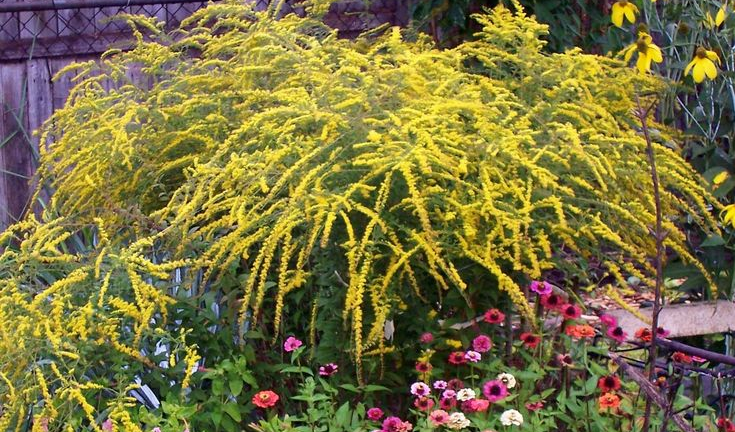Solidago rugosa, commonly known as rough goldenrod, is a hardy perennial plant native to North America. Known for its striking yellow flowers and resilience, this species of goldenrod has gained popularity among gardeners in various climates, including Georgia. This article explores the ability of Solidago rugosa to endure both the hot summers and mild winters of Georgia, providing insights and care tips for gardeners looking to keep this plant thriving throughout the year.
1. Understanding Solidago Rugosa
Solidago rugosa belongs to the Asteraceae family, which includes daisies and sunflowers. It typically grows to a height of 2 to 5 feet, with rough, textured leaves and clusters of small, vibrant yellow flowers that bloom from late summer into fall.
This perennial thrives in a variety of habitats, such as open fields, meadows, and woodland edges, and it is a key plant for pollinators like bees and butterflies. Its hardiness, drought tolerance, and relatively low maintenance make it an excellent choice for gardeners in Georgia looking to add both beauty and ecological value to their landscapes.
2. Growing Conditions for Solidago Rugosa in Georgia
Georgia’s climate is characterized by hot, humid summers and mild winters. Despite the challenges presented by these conditions, Solidago rugosa is well-suited for growth in Georgia’s diverse environments, making it an ideal addition to many landscapes. The plant thrives in USDA hardiness zones 4 to 9, which includes much of Georgia.
Sunlight Needs: Solidago rugosa thrives in full sun, requiring at least six hours of direct sunlight each day to grow well. In Georgia, where summers can be hot, full sun will ensure the plant produces a profusion of golden flowers. If planted in partial shade, the plant may still grow but will likely produce fewer flowers.
Soil Preferences: While Solidago rugosa can adapt to a variety of soil types, it prefers well-drained, slightly acidic to neutral soils. It will tolerate sandy, loamy, or even clayey soils as long as they do not retain too much water. Given Georgia’s typical clay-heavy soil, adding organic matter can help improve drainage and prevent waterlogging, which can lead to root rot.
3. Surviving the Georgia Summer
Georgia summers are known for their extreme heat, with temperatures often exceeding 90°F (32°C) during peak summer months. Solidago rugosa, however, is well-equipped to handle the sweltering summer heat, as long as it receives adequate care.
Watering: While Solidago rugosa is drought-tolerant once established, it will still require regular watering during hot summer spells, particularly if rainfall is insufficient. The key is to keep the soil consistently moist but not waterlogged. A layer of mulch around the base of the plant will help conserve moisture and protect the roots from intense heat.
Protection from Excessive Heat: Although Solidago rugosa thrives in full sun, planting it in a location that provides some afternoon shade can be beneficial during the hottest months, particularly in regions where the temperature exceeds 90°F for extended periods. Consider planting it next to taller plants or structures that provide natural shade in the afternoon.
Pests and Diseases: Hot, humid weather can lead to an increase in pest populations. Aphids, caterpillars, and spider mites are among the most common pests that may target Solidago rugosa in the summer. Regular inspection of the plant for pests and diseases, along with the use of organic treatments like insecticidal soap, can help keep your plant healthy.
4. Surviving the Georgia Winter
Georgia winters are typically mild compared to northern states, with occasional frost or freezes being the most extreme weather events. Fortunately, Solidago rugosa is cold-hardy and can handle Georgia’s winter temperatures, which rarely dip below freezing for extended periods.
Dormancy: Like many perennials, Solidago rugosa enters a state of dormancy during the winter months. This means that the plant conserves its energy in its roots while its above-ground growth slows down or dies back. While it may appear to be dead or inactive in winter, the plant is simply resting and preparing for the next growing season.
Protection from Frost: Although Georgia winters are generally mild, occasional cold spells can pose a threat to plants. Solidago rugosa is resilient, but to ensure the plant survives a sudden frost, you can protect it by adding a thick layer of mulch around the base of the plant. This insulation helps protect the roots from freezing temperatures.
Cutting Back in Fall: After the first frost, it is advisable to cut back the dead or damaged foliage to the ground. This will not only improve the plant’s appearance but also prevent the buildup of pests and diseases that could affect its growth in the spring. You may also choose to leave some of the flower heads intact for birds to enjoy during the winter months.
5. Spring and Summer Growth: How to Encourage Healthy Growth
When spring arrives and temperatures warm up, Solidago rugosa will begin to break dormancy and grow vigorously. With proper care, it will grow to its full height by summer and begin producing its beautiful golden flowers.
Fertilization: Although Solidago rugosa is not particularly demanding in terms of nutrients, it will benefit from a light feeding in the spring. Use a balanced, slow-release fertilizer to encourage healthy growth and abundant flowering. Over-fertilization should be avoided, as it may lead to excessive foliage growth at the expense of flowers.
Pruning: Pruning is not required for Solidago rugosa, but it can help maintain the plant’s shape and health. In early spring, remove any dead or damaged stems, and trim the plant back if it has become too leggy or overgrown. Deadheading, or removing spent flowers, will encourage the plant to produce more blooms and maintain a neat appearance.
6. The Benefits of Solidago Rugosa in Your Garden
In addition to its beauty, Solidago rugosa provides several benefits for gardeners:
Pollinator-Friendly: Solidago rugosa is a valuable plant for attracting pollinators such as bees, butterflies, and other beneficial insects. Its bright yellow flowers provide a crucial source of nectar during late summer and fall, when other flowers may be less abundant.
Erosion Control: With its deep root system, Solidago rugosa is an excellent plant for controlling soil erosion. It is often used in natural landscapes and restoration projects to stabilize soil on slopes or disturbed areas.
Low Maintenance: Once established, Solidago rugosa is a low-maintenance plant that requires minimal care. It is drought-tolerant, pest-resistant, and adaptable to a variety of soil types, making it an ideal choice for busy gardeners.
7. Common Issues and Solutions
While Solidago rugosa is a hardy plant, it may occasionally encounter issues in Georgia’s climate. Here are some common problems and solutions:
- Overwatering: Solidago rugosa is susceptible to root rot if it receives too much water. Ensure that the soil is well-drained, and water only when the top inch of soil feels dry. Mulching can help regulate soil moisture.
- Yellowing Leaves: Yellowing leaves may indicate a nutrient deficiency or insufficient sunlight. Ensure the plant receives adequate sun and consider adding compost or a balanced fertilizer to improve soil fertility.
- Falling Stems: If Solidago rugosa becomes too tall or top-heavy, its stems may flop over. To prevent this, trim the plant back early in the growing season to control its height and encourage bushier growth.
FAQs
- Can Solidago rugosa survive Georgia’s winter?
Yes, Solidago rugosa is hardy and can survive Georgia’s mild winters. Although the plant may die back to the ground, it will remain dormant and regrow from the roots in spring.
- How often should I water Solidago rugosa during the summer?
During hot summer months, water Solidago rugosa regularly to keep the soil consistently moist. However, avoid overwatering, as this can lead to root rot. Once established, the plant is somewhat drought-tolerant.
- Can Solidago rugosa grow in partial shade in Georgia?
Solidago rugosa can tolerate some shade, but it thrives best in full sun. In areas with intense afternoon heat, partial shade can help protect the plant from the harshest sun, but it may reduce the amount of flowers produced.
Conclusion:
Solidago rugosa is an adaptable and resilient plant that can thrive in Georgia’s diverse climate. With proper care during both the hot summer months and the cooler winter period, it will continue to provide stunning yellow flowers and ecological benefits for years to come. Whether you are looking to add beauty to your garden, attract pollinators, or prevent soil erosion, Solidago rugosa is a great choice for any gardener in Georgia.


